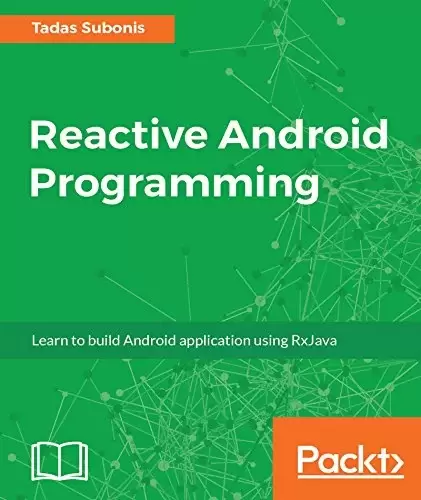
Book Description
Key Features
- Install and set up RxJava for android development
- Implement the reactive paradigm for Android programming using RxJava
- Create cutting edge real world android apps with reactive programming.
Book Description
Writing code on Android is hard. Writing a high quality code that involves concurrent and parallel tasks is even harder. Ensuring that this code will run without unforeseen race conditions is on the order of magnitude harder. RxJava is the tool that can help write code for such tasks.
In this book a novice developer will be introduced to a wide variety of tools that RxJava provides to enable them to produce robust and high-quality code for their asynchronous tasks by building a relatively simple application that will use advanced RxJava techniques to produce a high quality product.
First of all, the book will lead a developer through RxJava an initial setup in Android environment in Part 1. Later in the second part the reader will learn RxJava 2.0 step-by-step by starting off with stock data processing and display. Together with this a developer will learn to choose appropriate Schedulers and to use Retrofit library for remote requests. Further in Part 3, the reader will also learn advanced topics such as adding integration to Twitter to process its streaming data by combining it with stock data.
What you will learn
- Setup the environment for asynchronous android programming
- Write custom observables and higher level abstractions
- Orchestrate multiple calls using Reactive principles
- Fetch remote financial data using RxJava
- Integrate and process Twitter streams gracefully
- Utilize reactive programming for developing interactive and responsive android apps
About the Author
Tadas Subonis had started coding roughly when he was thirteen. Since then, he has done programming with PHP, JavaScript, Python, C++, and Java (the language in which he probably has written the most code). He took onto Android relatively recently – around 2014 (while he had a few more gentle tries in 2012).
However, he has soon learned that Android lacks a decent support for asynchronous programming (Async Task was/is a joke) while more reckless languages such as JavaScript had Promises for a long time. Furthermore, Java’s standard library was lacking a decent support for functional programming primitives (map, filter) but that was easily fixable with libraries such as Guava.
This lead me to a search of a library that would help me achieve Promise-like functionality and interface. It didn’t take long until I’ve found ReactiveX and their family of implementations (including RxJava) to handle streams in reactive fashion. It wasn’t exactly the flow of Promised-like systems but soon enough I’ve realized that it’s something even more powerful.
Since then, he has been using RxJava (and RxKotlin) for his daily Android programming. The quality of the code (lack of bugs, readability, and maintainability) improved ten-fold. Snappy and crash-free experience for the users of your application is a must these days when competition for user attention on app marketplaces is getting fiercer and fiercer.
Table of Contents
Chapter 1. Building Your First “Hello World” Rxjava Application
Chapter 2. Understanding The Basics Of Rxjava
Chapter 3. Learning To Use Retrofit By Fetching Financial Data
Chapter 4. Integrating Rxjava 1.0 With Rxjava 2.0
Chapter 5. Writing Data To Sqlite And Schedulers
Chapter 6. Error Handling And Sqlite Data Reading
Chapter 7. Integrating Rxjava With Activity Lifecycle
Chapter 8. Writing Custom Observables
Chapter 9. Advanced Observable Flows Explained
Chapter 10. Higher Level Abstractions
Chapter 11. Basics Of Subjects And Preference Persistence
Chapter 12. Learning To Read Marble Diagrams
中文:
书名:反应式Android编程
主要特点
- 安装和设置用于Android开发的RxJava
- 使用RxJava实现用于Android编程的反应式范例
- 使用反应式编程创建尖端的现实世界Android应用程序。
Book Description
在Android上编写代码很难。编写涉及并发和并行任务的高质量代码就更难了。要确保这段代码在没有不可预见的竞争条件的情况下运行,难度要大得多。RxJava是可以帮助编写此类任务代码的工具。
在本书中,将向新手开发人员介绍RxJava提供的各种工具,使他们能够通过构建使用高级RxJava技术来生成高质量产品的相对简单的应用程序,来为他们的异步任务生成健壮且高质量的代码。
首先,本书将在第1部分中引导开发人员在Android环境中进行RxJava的初始设置。稍后,在第二部分中,读者将从股票数据处理和显示开始,逐步学习RxJava 2.0。除此之外,开发人员还将学会选择合适的调度器并使用Retrofit库来处理远程请求。在第3部分中,读者还将学习高级主题,例如向Twitter添加集成,以便通过将其与股票数据相结合来处理其流数据。
What you will learn
- 设置用于异步Android编程的环境
- Write custom observables and higher level abstractions
- 使用反应性原则协调多个呼叫
- 使用RxJava获取远程财务数据
- 优雅地集成和处理Twitter流
- 利用反应式编程开发交互式和响应性的Android应用程序
About the Author
塔达斯·苏博尼斯 大约在他13岁的时候开始编程。从那时起,他开始使用PHP、JavaScript、Python、C++和Java(可能是他编写代码最多的语言)进行编程。他是最近才开始使用安卓系统的–大约在2014年(2012年,他又进行了几次温和的尝试)。
然而,他很快就了解到,Android缺乏对异步编程的像样的支持(Async Task过去是/现在是一个笑话),而更鲁莽的语言,如JavaScript,长期以来一直有承诺。此外,Java的标准库缺乏对函数式编程原语(map、Filter)的良好支持,但这很容易用Guava等库修复。
这导致我搜索一个库,它将帮助我实现类似于Promise的功能和界面。没过多久,我就发现了Reactive X和他们的系列实现(包括RxJava),能够以被动的方式处理流。这并不完全是承诺的系统流,但很快我就意识到它是更强大的东西。
从那时起,他就一直在使用RxJava(和RxKotlin)进行日常的Android编程。代码的质量(缺少错误、可读性和可维护性)提高了十倍。如今,在应用程序市场上争夺用户注意力的竞争变得越来越激烈的时候,为应用程序的用户提供快速、无崩溃的体验是必须的。
Table of Contents
第1章.构建您的第一个“Hello World”RxJava应用程序
第2章:了解RxJava的基础知识
第3章:通过获取财务数据学习使用改装
第4章.集成RxJava 1.0和RxJava 2.0
Chapter 5. Writing Data To Sqlite And Schedulers
第6章.错误处理和Sqlite数据读取
第7章.将RxJava与活动生命周期集成
Chapter 8. Writing Custom Observables
第9章:高级可观测流动说明
Chapter 10. Higher Level Abstractions
第11章科目和偏好持续性的基础知识
第12章.学习阅读大理石示意图
评论前必须登录!
注册